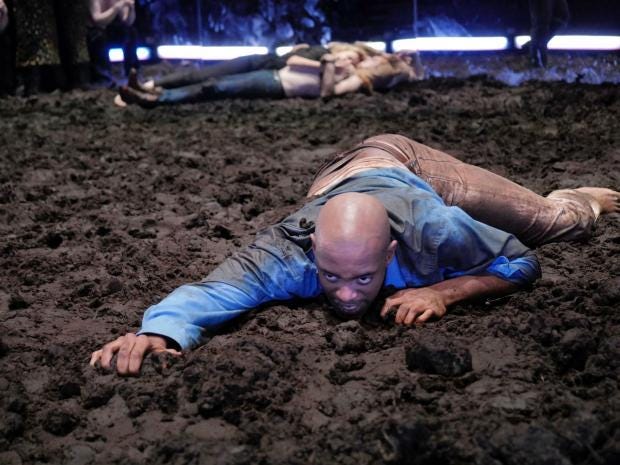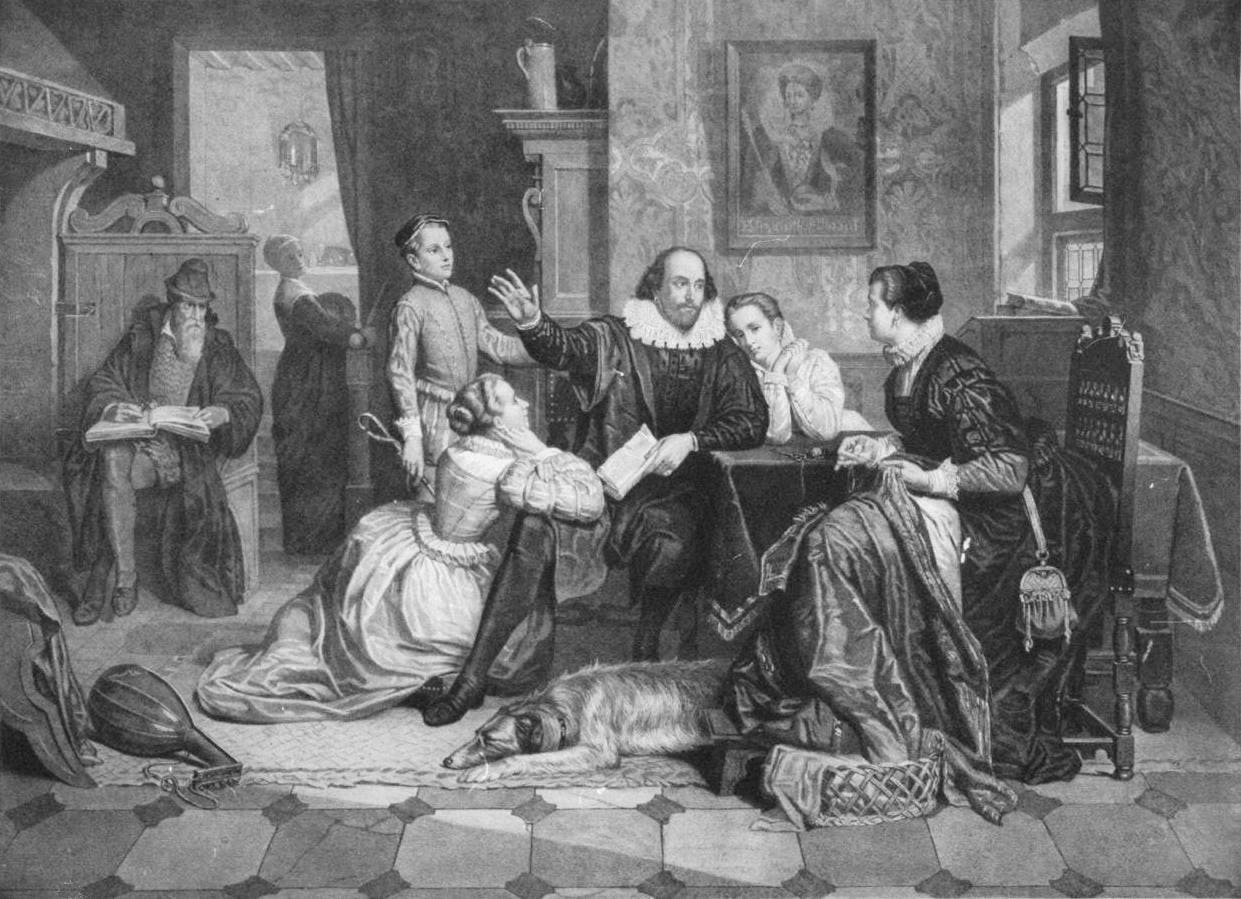MACBETH
Macbeth - what is it about?
'Macbeth', a tale of bloodshed, deceit, magic and lies, was written in 1603. The play is set in Scotland and follows the rise and fall of a once brave soldier, Macbeth, who resorts to murder to make true a prophecy he has heard, that one day he will be King of Scotland.

It was Shakespeare's first play since the coronation of the new king, James VI. James had written extensively on the topic of black magic, and specifically, witchcraft, in 'Daemonologie.' . Many argue that Shakespeare therefore wrote this play, in which three 'midnight hags' manipulate Macbeth until his death, to impress him. Or, could one argue that the play is a warning to the King, to not hold too much pride and ambition in his reign?
As a modern reading, I also now see the play as a study of the effects of returning from war. Macbeth, after killing hundreds in a battle, is congratulated and promoted, given no time to address the trauma of seeing and causing the death of others. His perception of what is good and evil is already warped - if he is a soldier, he is expected to have 'chivalrous, giving and brave' qualities, yet to brutally kill others, in a time where swords were the only weapon. How, then, can he see the murders of Duncan, Banquo and all others, as truly evil? In the play, I believe that his hallucinations, fits, paranoia and eventual descent into madness are an expression of the symptoms of PSTD, Post-Traumatic Stress Disorder. In Shakespeare's time, there was no recognition of 'mental health' or support offered, but in 2017 we can clearly see the reason for his descent.

The 'Three Witches' that lead Macbeth have a strong resemblance to The Fates in Greek Mythology, and since the play's publication, have been a strong influence in literary and artistic culture.
A quote that I feel sums up the message of the play is,
'I am in blood/Stepp'd in so far that, should I wade no more,/Returning were as tedious as go over.'
(Act 3, Scene 4)
This quote is expressing how, after the death of Duncan, there is no turning back, and Macbeth will have to keep wading forward through the metaphorical bloodshed of guilt and damage, until the end.
'Macbeth', a tale of bloodshed, deceit, magic and lies, was written in 1603. The play is set in Scotland and follows the rise and fall of a once brave soldier, Macbeth, who resorts to murder to make true a prophecy he has heard, that one day he will be King of Scotland.

It was Shakespeare's first play since the coronation of the new king, James VI. James had written extensively on the topic of black magic, and specifically, witchcraft, in 'Daemonologie.' . Many argue that Shakespeare therefore wrote this play, in which three 'midnight hags' manipulate Macbeth until his death, to impress him. Or, could one argue that the play is a warning to the King, to not hold too much pride and ambition in his reign?
As a modern reading, I also now see the play as a study of the effects of returning from war. Macbeth, after killing hundreds in a battle, is congratulated and promoted, given no time to address the trauma of seeing and causing the death of others. His perception of what is good and evil is already warped - if he is a soldier, he is expected to have 'chivalrous, giving and brave' qualities, yet to brutally kill others, in a time where swords were the only weapon. How, then, can he see the murders of Duncan, Banquo and all others, as truly evil? In the play, I believe that his hallucinations, fits, paranoia and eventual descent into madness are an expression of the symptoms of PSTD, Post-Traumatic Stress Disorder. In Shakespeare's time, there was no recognition of 'mental health' or support offered, but in 2017 we can clearly see the reason for his descent.

The 'Three Witches' that lead Macbeth have a strong resemblance to The Fates in Greek Mythology, and since the play's publication, have been a strong influence in literary and artistic culture.
A quote that I feel sums up the message of the play is,
'I am in blood/Stepp'd in so far that, should I wade no more,/Returning were as tedious as go over.'
(Act 3, Scene 4)
This quote is expressing how, after the death of Duncan, there is no turning back, and Macbeth will have to keep wading forward through the metaphorical bloodshed of guilt and damage, until the end.
When was it first performed?
On the 7th of August, in 1606, it is believed that 'Macbeth' was first performed for King James and his brother, at the Great Hall in Hampton Court Palace.
On the 7th of August, in 1606, it is believed that 'Macbeth' was first performed for King James and his brother, at the Great Hall in Hampton Court Palace.
A Contemporary Production
Rupert Goold's 2007 production of Macbeth first was performed at the Chichester Theatre Festival, and transferred to The West End. This contemporary production was a great success, and was made into a film. Critic for The Guardian, Michael Billington, said, 'Macbeth has lost none of its visceral excitement, political resonance or textual clarity.'
The concept of Goold's adaptation was to set the play in a kitchen, (designed by Anthony Ward) due to the many scenes in the play that include an element of ceremony, such as the banquet scene. Goold said, about the set, that it included 'wipe-clean white tiles, lamps, a clattering lift upstage. Halfway between kitchen and morgue.' In this soulless, white setting, the witches are military nurses, residing in a strange, cold time and place where Lady Macbeth washes blood from her hands in a shining white sink. The play is also politically fuelled, the protagonist a totalitarian tyrant, inspired by Stalin and the Soviet Union.
Lady Macbeth sleepwalks - Rupert Goold film adaptation
Patrick Stewart and Kate Fleetwood were cast as the protagonists in the play, Fleetwood actually Rupert Goold's wife. The casting of an older Macbeth worked for the context of the play, as he matched the same range as Stalin and was a believable dictator.
In this production, the character that I am playing, Banquo, returns to haunt Macbeth as a chilling, silent, expressionless presence. His strong stance, white shirt and good posture in the video below suggest to me his life as a soldier, the effect it had on his identity.
Banquo's Ghost Haunts Macbeth - Rupert Goold film adaptation
Below are some reflections about my character, Banquo, written during the rehearsal process:
The concept of Goold's adaptation was to set the play in a kitchen, (designed by Anthony Ward) due to the many scenes in the play that include an element of ceremony, such as the banquet scene. Goold said, about the set, that it included 'wipe-clean white tiles, lamps, a clattering lift upstage. Halfway between kitchen and morgue.' In this soulless, white setting, the witches are military nurses, residing in a strange, cold time and place where Lady Macbeth washes blood from her hands in a shining white sink. The play is also politically fuelled, the protagonist a totalitarian tyrant, inspired by Stalin and the Soviet Union.
Lady Macbeth sleepwalks - Rupert Goold film adaptation
Patrick Stewart and Kate Fleetwood were cast as the protagonists in the play, Fleetwood actually Rupert Goold's wife. The casting of an older Macbeth worked for the context of the play, as he matched the same range as Stalin and was a believable dictator.
In this production, the character that I am playing, Banquo, returns to haunt Macbeth as a chilling, silent, expressionless presence. His strong stance, white shirt and good posture in the video below suggest to me his life as a soldier, the effect it had on his identity.
Banquo's Ghost Haunts Macbeth - Rupert Goold film adaptation
Below are some reflections about my character, Banquo, written during the rehearsal process:
I feel that my character Banquo is coming to life more as we rehearse and I understand his journey to his tragic end. I am understanding just how hard it is to stand by Macbeth and stay silent about the witches’ prophecy, even after Duncan is killed. One could argue that his loyalty is a flaw that leads to his death - had he spoken out about his suspicions earlier, would events have unfolded differently. I think that he holds onto the hope that Macbeth is still good and gracious - as he has known him as a brave and kind friend for so long. As a character, he is almost too kind and too perfect as if Shakespeare crafted him to heighten the wrongs of Macbeth against such a great friend. And Banquo is also clever and cautious from the outset - he warns Macbeth against the ‘instruments of darkness’ in the first Act. I think that this shows that my character is able to think practically instead of get lost in ambition and greed - a trait Macbeth has less of. He, instead, becomes obsessed by the tantalising and torturous words of the witches, thinking of his own gaining of power.









